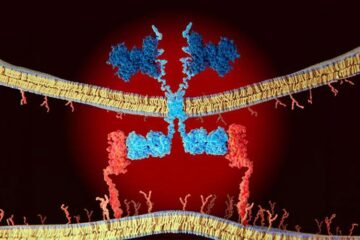World’s first line scanner

Unique terahertz line scanner with in-house fabricated terahertz detectors - as a technology demonstrator for inline quality control.
(c) Petra Immerz / FBH
… with monolithically integrated terahertz detectors for industrial applications.
The Ferdinand-Braun-Institut has developed a terahertz (THz) line scanner for plastic components, enabling cost-effective realization of larger scan line lengths in industrial environments. For the first time, the technology demonstrator is based entirely on monolithically integrated THz detectors.
There is hardly anyone who hasn’t encountered it yet, as terahertz radiation (THz) is routinely used at airports for security checks. It penetrates clothing, organic tissue, and many other materials including plastics, polymers, and ceramics. In industry, it is suited for non-destructive material testing and for identifying hidden objects, for example to detect defects in the material.
For such applications, the Ferdinand-Braun-Institut (FBH) in Berlin, has developed a terahertz line scanner that is unique in terms of scalability, throughput, and speed. The technology demonstrator consists of a novel detector head that scans plastic parts on a conveyor belt – this scan is transmitted to a monitor along with a video image.
With this FBH technology demonstrator, a terahertz line scanner has been realized for the first time whose detector head is based entirely on monolithically integrated THz detectors. Since the antenna structures are integrated on the chips, chip production can also be scaled efficiently and cost-effectively to larger scan line lengths. The THz detectors can generally be realized in a frequency range from about 100 gigahertz (GHz) to 2 terahertz both broadband or narrowband. The detector spacing is defined on the chip, allowing it to be significantly smaller than conventional implementations. This, in turn, increases the image resolution.
Technical details of the line scanner
The realized detector head consists of a 6 cm long detector line, which is composed of 20 individual chips with four THz detectors on each chip. This amounts to 80 detectors, arranged at a distance of 640 µm. Depending on the terahertz source selected, these detectors can be used in the frequency range between 100 GHz and up to 1.5 THz. The speed of the 27-centimeter-wide conveyor belt of the technology demonstrator can be variably adjusted – up to 1.5 meters per second.
Each THz detector signal is amplified and digitized with a resolution of 16 bits. The readout speed of the line can be up to 15,000 images per second. Measurements of the THz detectors provide a bandwidth of at least 2 GHz. Example measurements at 110 GHz with a sampling rate of 5,000 images per second demonstrate a recording speed of less than one second at a conveyor speed of 0.25 meters per second. This makes the THz line scanner an efficient and cost-effective solution for industrial applications.
Wissenschaftliche Ansprechpartner:
Dr. Adam Rämer
+49 30 6392-2789
adam.raemer@fbh-berlin.de
Weitere Informationen:
https://www.fbh-berlin.de/en/research/iii-v-electronics/terahertz-components-mod… – further information and videos with different THz sources showing examplary scans are provided here
Media Contact
All latest news from the category: Power and Electrical Engineering
This topic covers issues related to energy generation, conversion, transportation and consumption and how the industry is addressing the challenge of energy efficiency in general.
innovations-report provides in-depth and informative reports and articles on subjects ranging from wind energy, fuel cell technology, solar energy, geothermal energy, petroleum, gas, nuclear engineering, alternative energy and energy efficiency to fusion, hydrogen and superconductor technologies.
Newest articles

Economies take off with new airports
A global study by an SUTD researcher in collaboration with scientists from Japan explores the economic benefits of airport investment in emerging economies using nighttime satellite imagery. Be it for…

CAR T–cell immunotherapy targets
Pan-cancer analysis uncovers a new class of promising CAR T–cell immunotherapy targets. Scientists at St. Jude Children’s Research Hospital found 156 potential CAR targets across the brain and solid tumors,…

Stony coral tissue loss disease
… is shifting the ecological balance of Caribbean reefs. The outbreak of a deadly disease called stony coral tissue loss disease is destroying susceptible species of coral in the Caribbean…





















